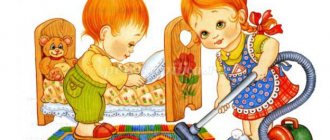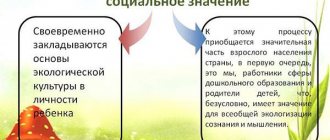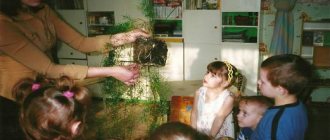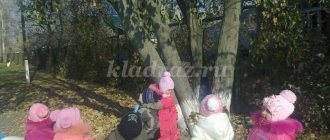Consultation for parents “Environmental education of children in the family”
Consultation for parents:
“Ecological education of children in the family”
Today, while raising our children , our new generation, we must take care not only of their development, moral principles and physical health. Environmental education of children also plays an important role more than ever .
Nowadays, the problems of environmental education have come to the fore, and more and more attention is being paid to them. Why did these problems become relevant? The reason is human activity in nature, often illiterate, incorrect from an environmental point of view , wasteful, leading to a violation of ecological balance .
a family is his place of birth and his main habitat. He has close people in who understand him and accept him for who he is. It is in the family the child learns the basics about the world around him. It is in the family the child’s ideas about good and evil are deposited.
The future is in our hands. The future we create today is our children. What we, parents , put into their thinking, into their lifestyle, into their life position will determine how the child, already at a conscious age, will relate to the world around him. After all, the consumer attitude towards the nature of our planet threatens not only the existence of individual ecosystems, but also humanity as a whole.
Ecology is “logos” - science and “oikas” - home, home, habitat; it is the science of the interactions of living organisms with each other and with the environment. This is all the living things that surround us, what we breathe, what we live with.
From the first years of life, children formulate the beginning of an ecological culture . Children see at home how their mother takes care of flowers, a cat or a dog. They themselves are drawn to all living things, they want to pet the animal and admire the beautiful flowers. Growing up, children learn that every creature has its own “home” , which contains everything for its life. Environmental education is the knowledge of living things that surround a child in their habitat, and our main task is to teach them to protect and take care of what they see. From a very early age, a child needs to instill a love for animals, plants, and natural beauty.
Environmental education in the family is , first of all, our example. Adults themselves should take care of nature and draw the attention of children to this . It would be good if parents taught how to throw garbage in special containers and not break branches on trees, but this is not enough for the child to fully realize his contribution to the future of the environment.
Preschool age is an important stage in the development of human ecological culture . During this period, the foundations of personality are laid, including a positive attitude towards nature and the surrounding world. At this age, the child begins to distinguish himself from the environment, an emotional and value-based attitude towards the environment develops, and the foundations of the moral and ecological positions of the individual , which are manifested in the child’s interactions with nature. At the same time, the accumulation of knowledge in preschool children They are a necessary condition for developing an emotional, moral and effective attitude towards the world.
Consultation for parents “Cultivating a caring attitude towards nature”
Consultation for kindergarten parents “Cultivating a caring attitude towards nature in preschool children”
“A person became a person only when he saw the beauty of the evening dawn and clouds floating in the blue sky, heard the nightingale singing and experienced admiration for the beauty of space.
Since then, thought and beauty go hand in hand, elevating and exalting man. But this ennoblement requires great educational efforts.” V. A. Sukhomlinsky Fostering high responsibility for the preservation of natural resources, their reasonable use and multiplication is the duty of every citizen.
It is very important to introduce a child to the world of nature from early childhood, teach him to love it and treat it with care: take care of plants on your property, in the park, in the forest, take care of animals, protect nature. Every person on earth should take care of nature conservation. Because we are not a separable part of it, and we are also a reasonable one! We must teach children to understand themselves and everything that happens around them. It is necessary to teach children to behave correctly in nature and among people. Often, due to lack of knowledge, they cannot choose the right course of action. The tasks of education are complicated by the fact that children often see how adults violate basic norms of communication with each other and with nature. Probably in such cases you need to say: “Even though they are adults, they don’t know that they shouldn’t speak rudely, leave garbage in recreation areas, carve inscriptions on tree trunks, offend stray animals, etc. You guys are great, you won’t do that.” A consciously correct attitude towards nature is based on an understanding of the connection of plants and animals with external conditions, their adaptability to the environment, the dependence of life and the state of the body on the influence of environmental factors and human activity. The starting point for developing a consciously correct attitude of preschoolers towards nature is a system of specific knowledge. Speaking about the specifics of the methodology of environmental education for preschoolers, it should be noted that its characteristic feature is the child’s direct contact with natural objects. When children communicate with nature, a contradiction often arises. On the one hand, they are very interested in plants and animals, they love them, on the other hand, they show cruelty and indifference. Why is this happening? The fact is that a preschool child does not know how to simply look at a butterfly, bird or kitten. He definitely needs to take possession of them. This often leads to children harming nature, and no explanation from adults helps. This is due to the preschooler’s ignorance of the rules of interaction with natural objects. Children have not yet developed the ability to pay attention to the state of objects of living and inanimate nature. Therefore, it is important to form in children ideas about nature and forms of attitude towards it, to teach them to love and protect nature, to form a sympathetic attitude towards representatives of the flora and fauna. The most important condition for instilling in children a humane attitude towards nature is their awareness of themselves as part of living nature. The child needs live communication with plants and animals, observations and practical activities to care for them, and comprehension of what he saw during the discussion.
Indirect knowledge of nature through books, slides, fairy tales, paintings, conversations, etc.
are of secondary importance. Its tasks are to expand and complement the impressions that the child receives from direct contact with natural objects. Every person, regardless of age, should treat nature with care and respect. In this regard, we adults who introduce children to nature are given the following tasks: - To cultivate in children emotional responsiveness, the ability to see and understand the beauty of nature, and to form aesthetic feelings. — Cultivate an interest in native nature, a desire to learn more about the nature of your region. — Develop a caring attitude towards nature, strive to create it. — When introducing children to nature, we must not only impart specific knowledge to them, but also evoke an emotional response in the soul of every child and awaken aesthetic feelings. As soon as the baby leaves the threshold on his own, he explores the surrounding nature with all his senses. From now on, it is useful for parents to be extremely attentive to the safety of the child. Just as the world around us is magical and beautiful, it can also be dangerous. The adult's position should be active enough to satisfy the child's inquisitive mind. A parent should be a kind mentor and an active storyteller. Your active explanations, conversations, instructions must be supported by personal example. Because the child forms a model of behavior - relationship with the world around him, watching you, copies your behavior! In upbringing, the unity of requirements of all participants in the process is also encouraged (that is, all family members should share your views on upbringing). It is also necessary to take into account an individual age approach (i.e., you need to explain to the child in words that he understands). Show sufficient firmness and validity in your explanations during the education process, then you will see the result. Careful, tactful communication with nature should be satisfied taking into account the time of year. It is recommended to take walks together in a park, forest, field, or to a pond. When going for walks, dress for the weather and don’t leave trash behind! In summer: • You can observe the varied flowering of the flower bed in the summer. Examine newly blooming flowers, remind children of the need to carefully handle the decoration of the earth. • When carrying out labor activities in flower beds and vegetable gardens, instill a caring attitude towards flowers and plants (watering, loosening the soil, thinning out plants, replanting, creating shading from the active sun). • At this time of year, insect life can be easily observed. Tell your child about diversity, structure, adaptive features, benefits, harms, miracles of transformation. • While taking walks, you can watch birds and their offspring. In dry times, you can make drinking bowls for birds and monitor their condition. • Observations of animals will also be useful. Pay attention to how animals behave in the hot season, what they look like, what they eat, etc. • When taking walks, remember to be safe, avoid overheating in the sun, and do not let communication with the animal world be too persistent with your and child's side. • Remember that man is the most perfect creation of nature. He has the power to preserve and enhance all the beauty of the world around him! • Let's live in harmony with nature. Protect and take care of her gifts! In autumn: • Observe the seeds for their diversity and adaptation to distribution in nature. Handle seeds with care and store them in bins in accordance with storage rules. • Watch the weather. Explain that there is no bad weather in nature. That the precipitation that falls in autumn is necessary for the earth to saturate it with moisture. • Watch the trees. Explain that the trees are preparing to “sleep” and therefore shed their leaves; if they do not do this, they will die in the winter. Form the ability to perceive the beauty of nature, develop the desire to rejoice and be surprised in the process of communicating with nature, learn to notice the beautiful in the world around you. • Take care of perennial plants, cover the roots of trees and shrubs with fallen leaves. • Make and hang feeders for wintering birds, provide constant patronage for birds during the cold season. • Explain to your child that animals should not be disturbed in the autumn, at this time the animals’ activity decreases, you need to be attentive to them, and not make noise in the forest, park, or on a pond. Noisy activities can provoke aggressive behavior in animals. In winter: • Observe the weather, falling snow, and the beauty of the winter nature of your native land. • Explain to your child the purpose of snow, tell the children that snow saturates the earth with water and beneficial salts. A person on such land will be able to grow a good harvest. The ground under the snow rests and becomes fertile. • Observe trees covered in snow. Participate in joint raids to insulate trees and shrubs with snow to prevent freezing. • Carry out systematic observation of birds in winter, make sure that the feeders are clean and filled with food. • Take walks in the forest, park, field. Leave bait on the stumps for forest dwellers. Be quiet in the forest. When going on an excursion, dress appropriately for the weather and avoid hypothermia. In spring: • It is recommended to monitor the weather in spring. Pay attention to the appearance of warm days, to the way the air smells in spring, to the fact that the days have become longer and the nights have become shorter, the weather is very changeable. Clarify knowledge about the types of precipitation and their significance for plants and animals. When walking, dress appropriately for the weather and avoid hypothermia. • While taking walks, tell your child that in spring nature wakes up from sleep, young shoots appear, the buds are very fragile and tender. And you can examine them very carefully, trying not to cause harm. • Invite the child to look at the fresh grass that has appeared, pay attention to its color and smell. Explain to the child that you need to walk carefully and not trample on it, because it is food for many animals that are weak after winter. • You can take a walk to the flower bed. Look at the flowers that appear on it. Tell your child that flowers are a decoration of our earth and should not be picked recklessly; in addition, they are a source of food for many insects. It is useful to instill an ecological culture as a result of joint, feasible labor actions with children (planting seedlings, watering plants, loosening the soil, tying them to supports, etc.) • while walking through a park, forest, meadow, explain to the child that animals awakened from It is better not to touch hibernation. Excessive anxiety can harm them and for a child, meeting an animal can be dangerous. • Spring is the nesting time for birds. We need to tell children about the life of birds in spring and observe them. Explain that it is forbidden to break bird nests and that making noise near existing nests is prohibited. Since this can prevent the birds from hatching their chicks and continuing their family. Try to build birdhouses together for visiting starlings. The beauty of our native nature also reveals the beauty of human labor and gives rise to the desire to make our region even more beautiful. Therefore, it is so important to show children how a person protects and multiplies natural resources, how much work he puts in to make forests and lakes, fields and rivers happy for everyone.
We recommend watching:
Consultation for parents of the younger group of preschool educational institutions. Consultation for parents. How to introduce your child to your hometown. Consultation for kindergarten parents on traffic rules. Child safety Consultation for kindergarten parents. Education with a fairy tale
Similar articles:
Introducing young children to small folklore forms
Stubborn child. How to raise him
MAGAZINE Preschooler.RF
Consultation for educators: “The role of the educator in the environmental education of a preschool child.”Teacher Esina Marina Aleksandrovna
MBDOU kindergarten "Belochka" Tambov, Tambov region.
When a child communicates with nature, a contradiction often arises. On the one hand, they are very interested in plants and animals, they love them, on the other hand, they show cruelty and indifference. Thus, children tear off the wings of insects and tear apart earthworms. Because of a momentary whim, children break branches of trees and bushes, tear them in armfuls and then, without regret, throw away flowering plants and trample lawns. At the same time, children do not regard their actions as a manifestation of evil.
Why is this happening? This is due, first of all, to preschoolers’ ignorance of the rules of interaction with natural objects.
On their own, it is difficult for preschoolers to see, for example, the manifestation of plant life, to understand that they, like other living beings, breathe, eat, move, and reproduce.
Therefore, adults come to the child’s aid, and in kindergarten, of course, a teacher who will help the child understand all the diversity of the world around him.
I would like to share the experience of my work in this direction, namely, what I did so that interaction with nature contributed to the formation of a friendly and correct attitude towards it in a preschooler.
Firstly, she tried to be a bearer of ecological culture and, through her behavior and actions, created a model of interaction with nature, a caring attitude towards it, and demonstrated the necessity and significance of everything that happens in front of children.
Secondly, she taught children to empathize and instilled in them an emotionally positive attitude towards nature. After all, emotions play a big role in the perception of nature, its beauty and uniqueness, as well as in showing sympathy for those who are in trouble, and a child is, as it were, “charged” with our emotions. Therefore, every time, at any opportunity, I admired natural objects and phenomena, found even the most unsightly, at first glance, object of nature and admired it. For example: I was surprised at the blue sky, white clouds and bright stars, a beautiful moth and a long worm, grass breaking through the asphalt, etc. She admired the good deeds of people, felt joy from the well-being of a living being and tried to “infect” children with this. Whenever possible, she always inserted a poetic word, and a poetic word will always leave an indelible mark in the heart of a child.
Thirdly, in no case should it be allowed that a child’s interaction with nature has a negative connotation.
And if an adult does not pay attention to this, children get used to dividing natural objects into beautiful and ugly, necessary and unnecessary, and build their attitude towards them accordingly. As a result, instead of accumulating positive emotions - surprise (for example, how interestingly a grasshopper has adapted to its environment), empathy (for example, a bug in trouble) - the child gains the experience of an indifferent or even heartless attitude towards objects that, in his opinion, are unpleasant.
The next point is introducing children to work.
Work activity must be regular. It is important for the teacher to introduce every child to it, since work in a corner of nature or in a kindergarten area contributes to the development of children’s powers of observation and curiosity, inquisitiveness, and arouses their interest in objects of nature and human labor.
In the process of working in nature, children develop knowledge about plants and animals (appearance, needs, methods of movement, habits, lifestyle, seasonal changes). Children learn to make connections between conditions, the way of life of an animal in nature and ways to care for it in a corner of nature.
When implementing environmental education, I tried to follow an integrated approach, which involves the interconnection of research activities, modeling, music, visual arts, physical education, games, theatrical activities, etc. It is this approach, in my opinion, that greens various types of child activities.
Working with parents.
A noticeable influence on the upbringing of a child is exerted by the way, level, quality and style of life of the family. Children are very sensitive to what they see around them. They behave like the adults around them.
Parents must realize that they cannot demand that their child follow any rule of behavior if adults themselves do not always follow it. For example, it is difficult to explain to children that they need to protect nature if the parents do not do this themselves. And the different demands made in kindergarten and at home can cause them confusion, resentment, or even aggression.
I work with parents in the form of meetings (general and group) in order to inform parents about joint work and stimulate their active participation in it. I invite them to classes, post a lot of visual material, and publish booklets on the topic of taking care of and protecting nature.
Now let's consider the question: how should this activity be organized in different age groups in order to realize its leading motive - the education of preschoolers in the principles of environmental culture - and achieve specific goals?
At early preschool age, children in joint activities are more observers than practical performers, and yet it is at this age that the pattern of interaction with nature is decisive: children hear and absorb the gentle conversation of an adult with animals and plants, calm and clear explanations about , what and how to do, they see the actions of the teacher and willingly take part in them. For example, having invited children to participate in watering indoor plants, the teacher says something like this: “Let's go to the window, look at our plants, talk to them and water them. (We went to the window.) Hello, flowers! How are you feeling? Are they not frozen or dry? (Examines the plants.) No, everything is fine - you are green and beautiful. Look how good our plants are, how nice it is to look at them! (Touches the soil in the pot.) Dry soil, but plants need water - they are alive, they cannot live without water! . " The teacher gives each child a watering can with a little water in it, waters everything himself, saying: “Ogonyok, we will pour a lot of water into your pot, drink as much as you want and continue to grow - we will admire you!” Children's participation in this joint activity consists of listening to the teacher's speech, observing his actions, holding watering cans, giving and receiving them, together filling them with water and putting them in place. The teacher takes care of the plants in front of the children and together with them - this is an example of interaction with nature. Learning as a didactic task is not in the foreground; it occurs by itself, naturally in the process of joint practical activity.
In the middle group, the teacher and children act together, although priority belongs to the adult, which is expressed in the formula: “I do - you help me, you are my assistants. We take care of our pets together!”
In older preschool age, children's independence rapidly increases, and it becomes possible for them to be on duty in a corner of nature. The adult and children change roles: the children do everything necessary themselves, and the teacher helps them (it doesn’t matter that the help at first can be very large). The teacher makes sure to note all the children’s achievements and praise them for their independence, confidence and initiative. Teachers who do everything themselves and do not give preschoolers the opportunity to observe and participate in creating normal conditions for the inhabitants of living corners, nature rooms, plots, develop in children indifference, callousness and inattention in general to life as a unique value.
These, in my opinion, are the basic conditions that are necessary for the environmental education of children.
| Next > |
Consultation for parents “Ecology and children”
Consultation for parents
"Ecology and Children"
For a child, a family is his place of birth and his main habitat. He has close people in his family who understand him and accept him for who he is - healthy or sick, kind or not so kind, flexible, he belongs there.
It is in the family that the child learns the basics about the world around him. It is in the family that the child’s ideas about good and evil are deposited. With loved ones, he experiences feelings of love, friendship, and duty. By its nature, family education is based on feeling. Feelings of love with all the harmony of the various nuances of its manifestation accompany the child in the family, from prenatal development to adulthood. This range of feelings has a beneficial effect on the development and upbringing of a child: it gives him a passing feeling of happiness, tenderness of existence, a sense of protection from external adversity, and in the person of parents - helpers, advisers, older friends. Moreover, the harmonious development of a child in a family is created by various manifestations of feelings of love among family members.
From the first years of life, children formulate the beginning of an ecological culture. Children see at home how their mother takes care of flowers, a cat or a dog. They themselves are drawn to all living things, they want to pet the animal and admire the beautiful flowers.
Growing up, children learn that every creature has its own “home”, which contains everything for its life. Environmental education is the knowledge of living things that surround a child in their habitat, and our main task is to teach them to protect and take care of what they see. You need to clearly explain to your child that breaking a tree branch is prohibited, especially in winter. Draw the child’s attention to the beauty, how beautiful they are in the frost. In winter they sleep and they have only us as protectors.
We need to cover the roots with snow, explaining that we are helping them survive in the winter. When you are in the forest with your children in winter, pay attention to the silence in the forest, its beauty and how well you can breathe in the forest.
In spring, nature transforms, and we rejoice at every new blade of grass and new leaf. Work at the dacha begins and the children help you, albeit very little, but they are drawn to it, seeing how you do it. There is a forest near the dacha areas; you go there with your children. We are all drawn to nature to relax, breathe fresh air, listen to the babbling of a stream. We adults collect flowers and medicinal herbs, pick only as much as you need, and try not to tear up the roots.
When picking mushrooms and berries in the forest, take only those that you know, and leave others alone. Animals need them, they feed on them and are treated with them. Like, for example, the fly agaric mushroom, it’s so beautiful, admire it, but don’t touch it, the elk will come and use it for treatment. To prevent mushrooms from disappearing from our forest, do not disturb the mycelium, explain to children that mushrooms need to be cut with a knife, a new mushroom will grow here.
Children often act cruelly to nature and we adults are to blame for all this. They couldn’t teach us to see the beautiful and make sure that everything that surrounds us only makes us happy.
Feed the birds, hang a feeder outside the window or on the balcony. The child will put the food there himself. If you want to please your child, get him a parrot or a goldfinch, a turtle or a hamster. Explain and teach how to properly care for them and the child will be happy. Many children have a dream to have a friend nearby, this is a kitten or puppy. And if you get yourself an animal at home, do not throw them out into the street when they grow up, they are animals and trust people. I wish you to cultivate a sense of compassion in children, teach them to see the beauty of the world around them and this will not be in vain. If a child treats everything with care and takes care of this “home”, your upbringing will not be in vain. They will be attentive not only to the world around them, but also to you adults.







